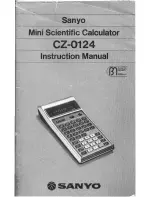
1–20
Getting
Started
File name 33s-English-Manual-040130-Publication(Edition 2).doc Page : 388
Printed Date : 2004/1/30 Size : 13.7 x 21.2 cm
Engineering Format ({
})
ENG format displays a number in a manner similar to scientific notation, except
that the exponent is a multiple of three (there can be up to three digits before the
"
" or "
" radix mark). This format is most useful for scientific and engineering
calculations that use units specified in multiples of 10
3
(such as micro–, milli–, and
kilo–units.)
After the prompt,
_, type in the number of digits you want after the first
significant digit. For 10 or 11 places, press
Ë
0 or
Ë
1.
For example, in the number
, the "2", "3", "4", and "6" are the
significant digits after the first significant digit you see when the calculator is
set to ENG 4 display mode. The "3" following the "
" is the (multiple of 3)
exponent of 10: 123.46 x 10
3
.
Pressing
_
or
º
]
will cause the exponent display for the number
being displayed to change in multiples of 3.
For example, key in the number
and pressing
_
will convert the
displayed value to
, which the mantissa
n
satisfies 1
≤
n
<
1000 and
the exponent is a multiple of 3. When you press
_
again, the displayed value
is converted to
by shifting the decimal point three places to the right
and converting the exponent to the next lower multiple of 3.
Key in the number
and pressing
º
]
will convert the
displayed value to
, which the mantissa
n
satisfies 0.01
≤
n
<
10 and
the exponent is a multiple of 3. When you press
º
]
again, the
displayed value is converted to
by shifting the decimal point
three places to the left and converting the exponent to the next higher multiple of 3.
ALL Format
({
})
ALL
format displays a number as precisely as possible (12 digits maximum). If all
the digits don't fit in the display, the number is automatically displayed in scientific
format.
SHOWing Full 12–Digit Precision
Changing the number of displayed decimal places affects what you see, but it
does not affect the internal representation of numbers. Any number stored
internally always has 12 digits.
Summary of Contents for 33S
Page 14: ......
Page 15: ...Part 1 Basic Operation ...
Page 16: ......
Page 56: ......
Page 64: ......
Page 82: ......
Page 92: ......
Page 122: ......
Page 138: ......
Page 157: ...Part 2 Programming ...
Page 158: ......
Page 184: ......
Page 210: ......
Page 222: ......
Page 293: ...Part 3 Appendixes and Reference ...
Page 294: ......
Page 324: ......
Page 348: ......
















































